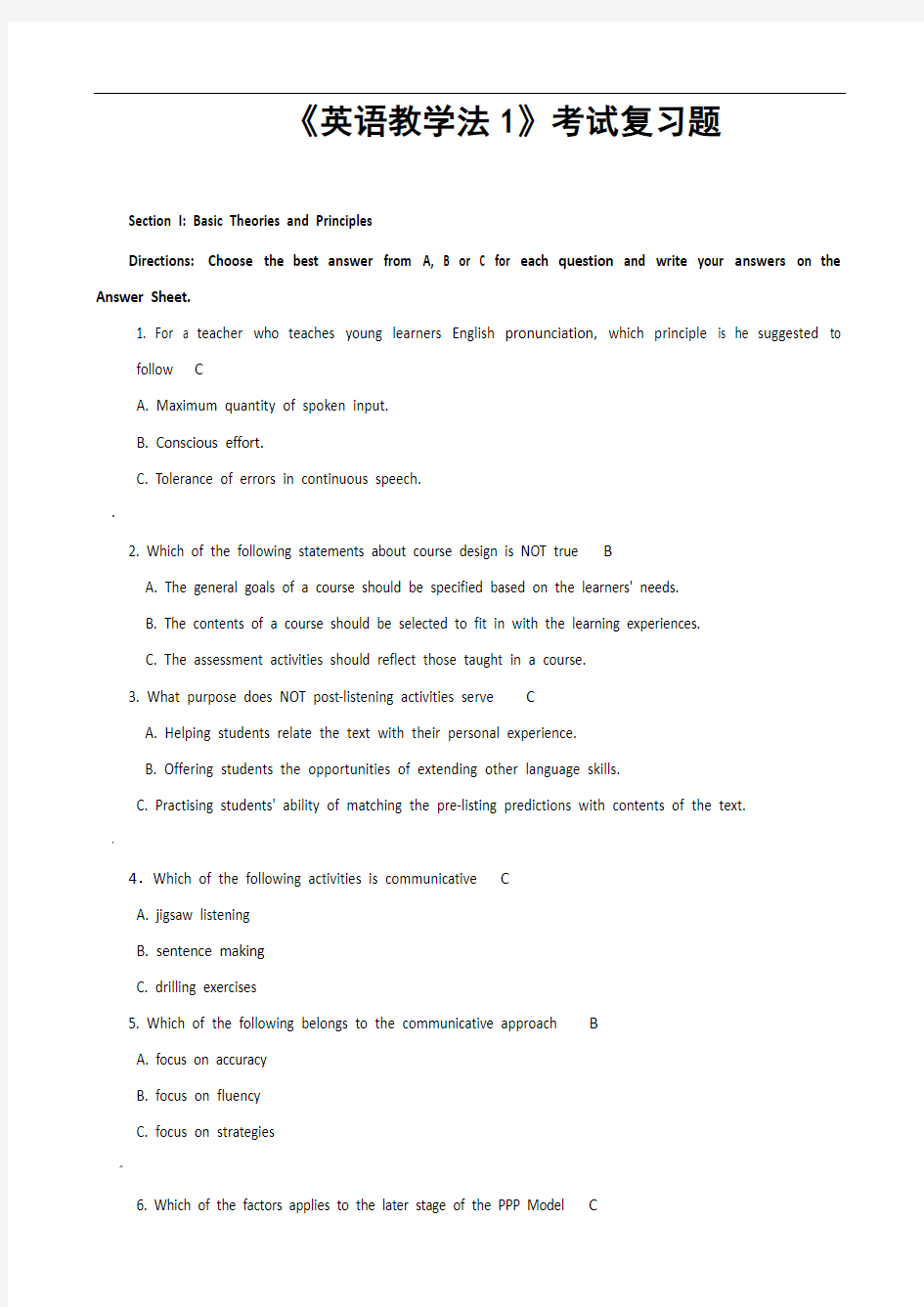电大《英语教学法1》考试复习题

- 1、下载文档前请自行甄别文档内容的完整性,平台不提供额外的编辑、内容补充、找答案等附加服务。
- 2、"仅部分预览"的文档,不可在线预览部分如存在完整性等问题,可反馈申请退款(可完整预览的文档不适用该条件!)。
- 3、如文档侵犯您的权益,请联系客服反馈,我们会尽快为您处理(人工客服工作时间:9:00-18:30)。
《英语教学法1》考试复习题
Section I: Basic Theories and Principles
Directions: Choose the best answer from A, B or C for each question and write your answers on the Answer Sheet.
1. For a teacher who teaches young learners English pronunciation, which principle is he suggested to
follow C
A. Maximum quantity of spoken input.
B. Conscious effort.
C. Tolerance of errors in continuous speech.
。
2. Which of the following statements about course design is NOT true B
A. The general goals of a course should be specified based on the learners' needs.
B. The contents of a course should be selected to fit in with the learning experiences.
C. The assessment activities should reflect those taught in a course.
3. What purpose does NOT post-listening activities serve C
A. Helping students relate the text with their personal experience.
B. Offering students the opportunities of extending other language skills.
C. Practising students' ability of matching the pre-listing predictions with contents of the text.
,
4.Which of the following activities is communicative C
A. jigsaw listening
B. sentence making
C. drilling exercises
5. Which of the following belongs to the communicative approach B
A. focus on accuracy
B. focus on fluency
C. focus on strategies
^
6. Which of the factors applies to the later stage of the PPP Model C
B. Class work.
C. Delayed correction.
7. Which of the following generally does NOT describe a CLT syllabus C
A. The vocabulary and grammar structures needed for communicative objectives(e. g. telling directions,
requesting information, expressing agreement, etc. ).
B. The skills required in typical situations (e. g. listening, speaking or writing skills).
C. The grammar rule appropriate for social occasions (e. g. at a conference, at a party, in a grocery store,
etc.)
…
8. Which of the following is characteristic of acquisition C
A. form-focused
B. accuracy-oriented
C. meaning-focused
9. What syllabus does the following present C
A. structural syllabus
B. topic syllabus
C. functional syllabus
10. When a teacher instructs the students to match the topic sentences with proper paragraphs, which one of the skills is he intending to develop of his students A
A. Skimming.
B. Scanning.
。
11. Which of the following is most suitable for the cultivation of linguistic competence A
A. sentence-making
B. cue-card dialogue
C. simulated dialogue
12. Which of the following activities is typical of the Grammar-translation Method C
A. The students listen to and act on commands in the target language.
B. The students whisper their words in the mother tongue to the teacher who then translate them into
the target language.
\
C. The students translate some sentences in the text into their mother tongue.
13. Which of the following emphasizes meaningfulness principle C
A. TPR
B. Audio-Lingual Method
C. Communicative Approach
14. Which of the following is true according to Krashen B
A. Babies learn their mother tongue.
B. Language acquisition can be achieved even without conscious effort.
(
C. A foreign language learner should develop his language skills in the order of listening, reading,
speaking and writing.
15. Which of the following is the teacher expected to do in a communicative activity B
A. To offer the students as little help as possible.
B. To check if the students have understood the instructions before the activity starts.
C. To correct the students' errors immediately after they occur.
16. What should the teacher try to avoid when selecting listening materials B
A. Te texts scripted and recorded in the studio.
B. The texts with implicated concepts beyond the comprehension of students.
)
C. The texts delivered through the accents other than RP or Standard American Pronunciation.
17. Which is the correct order of the following three speaking activities along the Control-Communication
